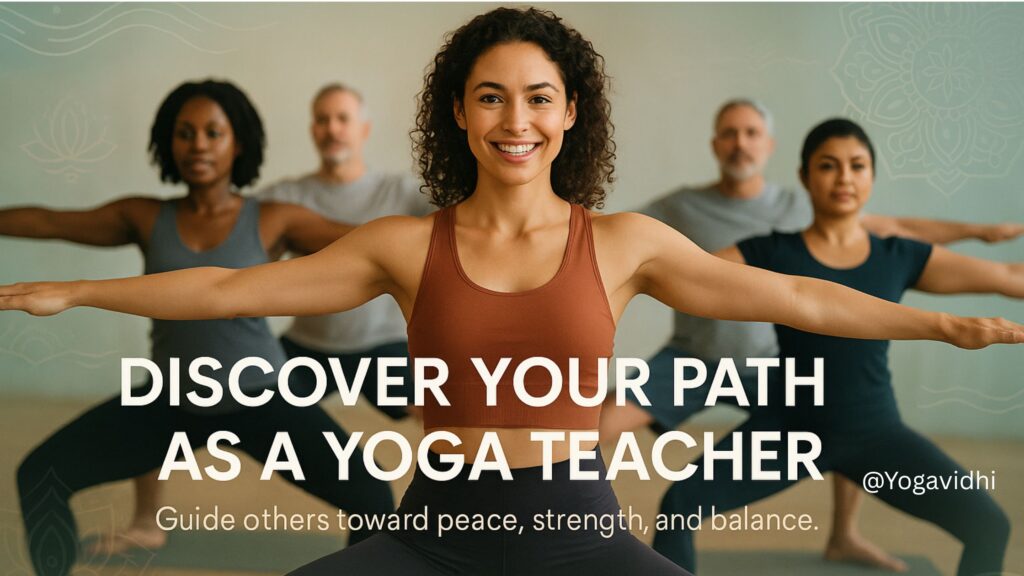Have you ever felt deeply connected during a yoga class, wondering what it would be like to guide others on their journey toward wellness? If so, becoming a yoga teacher might just be your true calling. In a world that’s increasingly chaotic, yoga teachers serve as anchors—helping others find peace, strength, and balance both physically and mentally.
Whether you’re exploring the idea or ready to take the leap, this comprehensive guide will show you everything you need to know about becoming a yoga teacher—from certifications to career opportunities, and even the challenges you might face along the way.
A yoga teacher is a trained professional who leads individuals or groups through various yoga practices such as physical postures (asanas), breathing exercises (pranayama), meditation, and relaxation techniques. Their role is to provide a safe, supportive space where students can explore both the physical and mental dimensions of yoga, encouraging personal development and overall well-being.
Table of Contents
Who is a Yoga Teacher?
At its core, a yoga teacher is someone who shares the ancient practice of yoga with others in a safe, authentic, and empowering way. They do more than guide physical postures (asanas)—they embody yogic principles in everyday life.
A yoga teacher serves as:
- A mentor who inspires personal growth
- A facilitator of mind-body-spirit connection
- A leader who creates inclusive and nurturing spaces for practice
Unlike general fitness instructors, yoga teachers delve into philosophy, pranayama (breath control), meditation, and ethical living (yamas and niyamas).
Why Become a Yoga Teacher?
Becoming a yoga teacher isn’t just a career move—it’s a lifestyle transformation. Here are some compelling reasons why people choose this path:
1. Deepen Your Own Practice
Through training and teaching, you gain a richer understanding of the body, mind, and breath—evolving far beyond what a regular yoga class can offer.
2. Career Flexibility
From local studios to online platforms, the demand for certified yoga instructors is growing rapidly. You can:
- Teach at studios, gyms, or community centers
- Launch your own yoga business
- Host retreats, workshops, or virtual classes
3. Make a Positive Impact
There’s nothing more fulfilling than helping someone heal or grow. As a yoga teacher, you contribute directly to your students’ physical, mental, and emotional wellbeing.
4. Personal and Spiritual Growth
Yoga teacher training isn’t just about learning to teach—it’s about understanding yourself. The inner transformation is as powerful as the professional one.
How to Become a Certified Yoga Teacher
If you’re wondering how to become a yoga teacher, you’re not alone—it’s one of the most searched questions online. Here’s a simplified roadmap to becoming a certified yoga teacher:
Step 1: Establish a Consistent Practice
Before teaching others, build a regular yoga practice. Understand different yoga styles like Hatha, Vinyasa, Yin, or Kundalini to discover what resonates with you.
Step 2: Choose a Yoga Teacher Training (YTT) Program
Look for a 200-hour Yoga Teacher Training—the most common starting point. Ensure it’s certified by a reputable body like Yoga Alliance.
Step 3: Complete Your YTT
In your training, you’ll learn:
- Anatomy and alignment
- Yoga philosophy (like the Yoga Sutras of Patanjali)
- Teaching methodology
- Breathwork and meditation
- Class sequencing and adjustments
Step 4: Get Certified and Start Teaching
Upon completion, you’ll receive a certificate allowing you to start teaching right away—online, in-person, or both.
Choosing the Right Yoga Teacher Training Program
Selecting the right YTT is crucial. Here’s what to look for:
Curriculum
Ensure the training includes a balance of theory, physical practice, and teaching methodology.
Online vs. In-Person
Online programs offer flexibility, while in-person YTTs provide immersive experience and deeper connection with teachers and peers.
Location
Some prefer local options, while others travel to yoga hubs like Rishikesh (India), Bali, or Costa Rica for a transformative experience.
Cost and Time Commitment
Programs can range from a few weeks to several months. Choose one that fits your lifestyle and budget.
Reputation
Read reviews and talk to alumni. Make sure the school is Yoga Alliance certified if you want a globally recognized credential.
Different Styles of Yoga You Can Teach
As a yoga teacher, you can specialize in different yoga styles based on your passion and student needs:
- Hatha Yoga – Gentle and foundational
- Vinyasa Yoga – Dynamic and flow-based
- Yin Yoga – Slow and meditative
- Restorative Yoga – Focused on deep relaxation
- Ashtanga Yoga – Structured and physically demanding
- Kundalini Yoga – Energy-focused and spiritual
- Chair Yoga – Ideal for seniors or those with limited mobility
- Prenatal Yoga – For expectant mothers
Each style requires its own approach, and many teachers get certified in multiple disciplines over time.
Read More: Yoga for Lower Back Pain: Natural Relief Through Gentle Movement
Read More: Yoga for Stress: Find Inner Peace with Every Breath
| Category | Details |
| Who is a Yoga Teacher? | A guide and mentor who teaches physical postures, philosophy, and breathwork, helping others grow physically, mentally, and spiritually. |
| Why Become a Yoga Teacher? | Deepen practice, enjoy flexible career options, help others, and experience personal/spiritual transformation. |
| Certification Required | 200-Hour Yoga Teacher Training (YTT), preferably certified by Yoga Alliance. Advanced levels: 300-Hour & 500-Hour. |
| How to Get Certified | 1. Consistent practice 2. Enroll in YTT 3. Complete coursework 4. Start teaching |
| Popular Yoga Styles to Teach | Hatha, Vinyasa, Ashtanga, Yin, Restorative, Kundalini, Prenatal, Chair Yoga |
| Training Options | Online or In-person Location flexibility Varying costs and timelines |
| Career Opportunities | Studio classes, private clients, online teaching, retreats, workshops, corporate yoga, merchandise |
| Challenges | Inconsistent income, physical burnout, student retention, self-doubt |
| Essential Tools & Resources | Teaching apps, sequencing platforms, books, anatomy guides, community support, scheduling software |
| Ethical Responsibilities | Consent-based teaching, inclusivity, cultural respect, authentic lifestyle |
| Common FAQs | Duration, certification needs, online training validity, salary expectations, flexibility requirements |
Building a Career as a Yoga Teacher
Start Teaching Small
Begin by teaching friends, community classes, or volunteering at local centers. This builds confidence and helps you develop your teaching voice.
Establish an Online Presence
Create a website or use platforms like YouTube, Instagram, or Zoom to expand your reach. The digital space offers countless opportunities.
Find Your Niche
Do you enjoy working with seniors, kids, or corporate clients? Finding a niche helps you stand out and build a loyal student base.
Understand the Business
Learn about pricing, marketing, and legalities (like insurance). Many yoga teachers supplement their income with:
- Workshops and retreats
- Affiliate programs
- Yoga merchandise or online courses
Challenges Faced by Yoga Teachers
While the yoga teacher journey is rewarding, it isn’t without challenges:
- Inconsistent income – Especially when starting out
- Physical burnout – Teaching too many classes without rest
- Student retention – Keeping students engaged in a competitive market
- Overcoming self-doubt – Especially early in your teaching career
Self-care, continuous learning, and community support can help you navigate these hurdles.
Must-Have Tools and Resources for Yoga Teachers
Teaching Tools
- Sequencing apps (like Tummee or Pocket Yoga)
- Music playlists
- Anatomy guides
Online Platforms
- Zoom, Teachable, or Kajabi for virtual classes
- Canva for creating promotional materials
Books Every Yoga Teacher Should Read
- The Heart of Yoga by T.K.V. Desikachar
- Light on Yoga by B.K.S. Iyengar
- The Yoga Sutras of Patanjali
Join a Community
- Facebook groups, local teacher meetups, or alumni networks keep you inspired and connected.
Ethics and Responsibilities of a Yoga Teacher
Being a yoga teacher is a sacred responsibility. Ethical conduct and professional boundaries are crucial for maintaining trust and integrity.
- Respect all bodies – Make yoga accessible and inclusive
- Avoid over-touching or adjusting without consent
- Honor yoga’s roots – Teach with cultural sensitivity and authenticity
- Walk the talk – Live your yoga off the mat through compassion, mindfulness, and integrity
Final Thoughts: Is Becoming a Yoga Teacher Worth It?
Absolutely. Becoming a yoga teacher is more than a profession—it’s a pathway to a more meaningful, connected, and balanced life. It allows you to transform your own life while uplifting others.
Whether you dream of leading global retreats or simply sharing peace in your local community, your journey begins with one step. Commit to your passion, trust the process, and let yoga guide your path forward.

Ready to Begin?
Explore certified Yoga Teacher Training programs today and start your journey toward a fulfilling, impactful career in yoga.
Frequently Asked Questions (FAQs):
Q. How long does it take to become a yoga teacher?
Ans: Most 200-hour yoga teacher training programs can be completed in 1 to 3 months (full-time) or over several weekends (part-time).
Q. Can I become a yoga teacher without certification?
Ans: Technically, yes—but being certified adds credibility, improves safety, and is often required by studios and insurers.
Q. Is online yoga teacher training valid?
Ans: Yes, especially if it’s Yoga Alliance-approved. Many schools now offer high-quality virtual training options.
Q. What is the average yoga teacher salary?
Ans: It varies greatly based on location, experience, and work style. Freelancers may earn ₹500–₹2000/hour or more, while full-time teachers can earn higher with retreats, online courses, or private sessions.
Q. Do I need to be very flexible to become a yoga teacher?
Ans: Absolutely not! Yoga teaching is about knowledge, presence, and communication—not touching your toes.
Q. What is a yoga teacher?
Ans: A yoga teacher is a wellness and fitness expert who guides group yoga sessions. They instruct students on performing different stretching poses, encourage meditation, and foster mindfulness to support overall well-being.
Q. What makes a good yoga teacher?
Ans: Set the tone by practicing what you teach.
Stay authentic and true to yourself.
Guide students toward a deep and holistic yoga experience.
Offer minimal but meaningful corrections.
Decide mindfully whether to keep eyes closed or open during practice.
Weave yoga philosophy naturally into physical postures.
Most importantly, make time for your own regular practice.
Q. What is the purpose of a yoga teacher?
Ans: They are skilled in guiding students through correct alignment, breathing practices, and appropriate modifications to suit various body types and abilities, ensuring safety and a positive experience for everyone involved.
Declaration Note:
We use third-party videos and images on https://yogavidhi.com/ for educational and illustrative purposes. All rights belong to their respective owners. No copyright infringement is intended.



